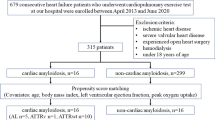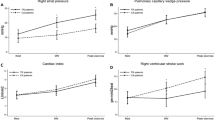Abstract
CardioPulmonary Exercise Test (CPET) is the gold standard to evaluate functional capacity in patients at high risk of heart failure (HF). Few studies with a limited number of subjects and conflicting results, analyzed the role of CPET in patients with systemic amyloidosis. Aims of our study were the assessment of the response to exercise in patients with Transthyretin amyloid (ATTR) cardiomyopathy (CA), and the correlation of clinical, biohumoral and echocardiographic parameters with CPET parameters, such as VO2 peak and VE/VCO2 slope. From February 2018 to March 2019, 72 cardiac ATTR patients were prospectively enrolled and underwent a complete clinical, biohumoral, echocardiographic and CPET assessment. All patients completed the exercise stress test protocol, without any adverse event. At CPET, they achieved a mean VO2 peak of 14 mL/Kg/min and a mean VE/VCO2 slope of 31. The blood pressure response to exercise was inadequate in 26 (36%) patients (flat in 25 and hypotensive in 1), while 49/72 patients (69%) showed an inadequate heart rate recovery. In multivariate analysis, s’ tricuspidalic was the only independent predictor of VO2 peak, while in the two test models performed to avoid collinearity, both TAPSE and s’ tricuspidalic were the strongest independent predictors of VE/VCO2 slope. Our data demonstrate the role of right ventricular function as an independent predictor of exercise capacity and ventilatory efficiency in ATTR. In CPET evaluation, a significant proportion of patients presented an abnormal arterial pressure response and heart rate variation to exercise.
Similar content being viewed by others
References
Merlini G, Bellotti V (2003) Molecular mechanisms of amyloidosis. N Engl J Med 349:583–596
Perfetto F, Cappelli F, Bergesio F, Ciuti G, Porciani MC, Padeletti L et al (2013) Cardiac amyloidosis: the heart of the matter. Intern Emerg Med 8:191–220
Corrà U, Agostoni PG, Anker SD, Coats AJS, Crespo Leiro MG, de Boer RA et al (2018) Role of cardiopulmonary exercise testing in clinical stratification in heart failure. A position paper from the committee on exercise physiology and training of the heart failure association of the European society of cardiology. Eur J Heart Fail 20(1):3–15
Reddy YNV, Olson TP, Obokata M, Melenovsky V, Borlaug BA (2018) Hemodynamic correlates and diagnostic role of cardiopulmonary exercise testing in heart failure with preserved ejection fraction. JACC Heart Fail 6(8):665–675
Nadruz W Jr, West E, Sengelov M, Santos M, Groarke JD, Forman DE et al (2017) Prognostic value of cardiopulmonary exercise testing in heart failure with reduced, midrange, and preserved ejection fraction. J Am Heart Assoc 6:11
Connors LH, Sam F, Skinner M, Salinaro F, Sun F, Ruberg FL et al (2016) Heart failure resulting from age-related cardiac amyloid disease associated with wild-type transthyretin: a prospective. Observ Cohort Study Circul 133(3):282–290
Hein S, Aus Dem Siepen F, Bauer R, Katus Arnt V, Kristen HA (2018) Peak V’O2 is an independent predictor of survival in patients with cardiac amyloidosis. Amyloid 25(3):167–173
Yunis A, Doros G, Luptak I, Connors LH, Sam F (2019) Use of ventilatory efficiency slope as a marker for increased mortality in wild-type transthyretin cardiac amyloidosis. Am J Cardiol 00:1–9
Gillmore JD, Maurer MS, Falk RH, Merlini G, Damy T, Dispenzieri A, Wechalekar AD et al (2016) Nonbiopsy diagnosis of cardiac transthyretin amyloidosis. Circulation 133(24):2404–2412
Gillmore JD, Damy T, Fontana M, Hutchinson M, Lachmann HJ, Martinez-Naharro A et al (2018) A new staging system for cardiac transthyretin amyloidosis. Eur Heart J 39:2799–2806
Lang RM, Badano LP, Mor-Avi V, Afilalo J, Armstrong A, Ernande L et al (2015) Recommendations for cardiac chamber quantification by echocardiography in adults: an update from the American society of echocardiography and the European association of cardiovascular imaging. J Am Soc Echocardiogr 28:e14
Wasserman K, Hansen JE, Sue DY, Stringer WW, Sietsema M, Sun X-G et al (2005) Principles of exercise testing and interpretation: including pathophysiology and clinical applications, 4th edn. Lippincott Williams and Wilkins, Philadelphia, p 585
Guazzi M, Adams V, Conraads V, Halle M, Mezzani A, Vanhees L et al (2012) European association for cardiovascular prevention and rehabilitation; American heart association EACPR/AHA scientific statement. Clinical recommendations for cardiopulmonary exercise testing data assessment in specific patient populations. Circulation 126(18):2261–2274. https://doi.org/10.1161/CIR.0b013e31826fb946(Epub 2012 Sep 5)
Malhotra R, Bakken K, D'Elia E, Lewis GD (2016) Cardiopulmonary exercise testing in heart failure. JACC Heart Fail 4(8):607–616. https://doi.org/10.1016/j.jchf.2016.03.022Epub 2016 Jun 8
Balady GJ, Arena R, Sietsema K, Myers J, Coke L, Fletcher GF et al (2010) American heart association exercise, cardiac rehabilitation, and prevention committee of the council on clinical cardiology; council on epidemiology and prevention; council on peripheral vascular disease; interdisciplinary council on quality of care and outcomes research. Clinician’s guide to cardiopulmonary exercise testing in adults: a scientific statement from the American heart association. Circulation 122(2):191–225. https://doi.org/10.1161/CIR.0b013e3181e52e69
Holland AE, Spruit MA, Troosters T, Puhan MA, Pepin V, Saey D et al (2014) An official European respiratory society/American thoracic society technical standard: field walking tests in chronic respiratory disease. Eur Respir J 44(6):1428–1446
Corrà U, Giordano A, Bosimini E, Mezzani A, Piepoli M, Coats AJ et al (2002) Oscillatory ventilation during exercise in patients with chronic heart failure: clinical correlates and prognostic implications. P Chest 121(5):1572–1580
Cappelli F, Frusconi S, Bergesio F et al (2016) The Val142Ile transthyretin cardiac amyloidosis: not only an Afro-American pathogenic variant? A single-centre Italian experience. J Cardiovasc Med (Hagerstown) 17(2):122–125. https://doi.org/10.2459/JCM.0000000000000290
Perfetto F, Cappelli F, Bergesio F (2011) Asymptomatic homozygous gene carrier in a family with Ile68Leu ATTR amyloidosis: a new endemic region in northern Tuscany? J Cardiovasc Med (Hagerstown) 12(6):450–451. https://doi.org/10.2459/JCM.0b013e3283464e12
Perugini E, Guidalotti PL, Salvi F, Cooke RM, Pettinato C, Riva L et al (2005) Noninvasive etiologic diagnosis of cardiac amyloidosis using 99mTc-3,3-diphosphono-1,2-propanodicarboxylic acid scintigraphy. J Am Coll Cardiol 46:1076–1084
Cappelli F, Gallini C, Di Mario C, Costanzo EN, Vaggelli L, Tutino F et al (2019) Accuracy of 99mTc-Hydroxymethylene diphosphonate scintigraphy for diagnosis of transthyretin cardiac amyloidosis. J Nucl Cardiol 26(2):497–504
Gallini C, Tutino F, Martone R, Ciaccio A, Costanzo EN, Taborchi G, Morini S, Bartolini S, Farsetti S, Di Mario C, Perfetto F, Cappelli F et al (2019) Semi-quantitative indices of cardiac uptake in patients with suspected cardiac amyloidosis undergoing 99mTc-HMDP scintigraphy. J Nucl Cardiol. https://doi.org/10.1007/s12350-019-01643-w
González-López E, Gallego-Delgado M, Guzzo-Merello G, de Haro-Del Moral FJ, Cobo-Marcos M, Robles C, Bornstein B et al (2015) Wild-type transthyretin amyloidosis as a cause of heart failure with preserved ejection fraction. Eur Heart J 36(38):2585–2594
Smorti M, Cappelli F, Bergesio F, Perfetto F (2012) Anxiety and depression among AL amyloidosis patients: the role of cardiac symptoms. Amyloid 19(3):123–128
Boldrini M, Cappelli F, Chacko L et al (2020) Multiparametric echocardiography scores for the diagnosis of cardiac amyloidosis. JACC Cardiovasc Imag 13(4):909–920. https://doi.org/10.1016/j.jcmg.2019.10.011
Chacko L, Martone R, Bandera F et al (2020) Echocardiographic phenotype and prognosis in transthyretin cardiac amyloidosis. Eur Heart J 41(14):1439–1447. https://doi.org/10.1093/eurheartj/ehz905
Lund LH, Aaronson KD, Mancini DM (2005) Validation of peak exercise oxygen consumption and the heart failure survival score for serial risk stratification in advanced heart failure. Am J Cardiol 95:734–741
Wagner J, Agostoni P, Arena R, Belardinelli R, Dumitrescu D, Hager A et al (2018) The role of gas exchange variables in cardiopulmonary exercise testing for risk stratification and management of heart failure with reduced ejection fraction. Am Heart J 202:116–126
Myers J, Oliveira R, Dewey F, Arena R, Guazzi M, Chase P et al (2013) Validation of a cardiopulmonary exercise test score in heart failure. Circ Heart Fail 6(2):211–218
Alba AC, Adamson MW, MacIsaac J, Lalonde SD, Chan WS, Delgado DH et al (2016) The added value of exercise variables in heart failure prognosis. J Card Fail 22(7):492–497
Trikas A, Rallidis L, Hawkins P, Oakley CM (1999) Comparison of usefulness between exercise capacity and echocardiographic indexes of left ventricular function in cardiac amyloidosis. Nihoyannopoulos P. Am J Cardiol 84:1049–1054
Ghio S, Gavazzi A, Campana C, Inserra C, Klersy C, Sebastiani R et al (2001) Independent and additive prognostic value of right ventricular systolic function and pulmonary artery pressure in patients with chronic heart failure. J Am Coll Cardiol 37(1):183–188
Chatterjee NA, Murphy RM, Malhotra R, Dhakal BP, Baggish AL, Pappagianopoulos PP et al (2013) Prolonged mean VO2 response time in systolic heart failure: an indicator of impairedright ventricular-pulmonary vascular function. Circ Heart Fail 6:499–507
Guazzi M, Villani S, Generati G, Ferraro OE, Pellegrino M, Alfonzetti E et al (2016) Right ventricular contractile reserve and pulmonary circulation uncoupling during exercise challenge in heart failure. J Am Coll Cardiol HF 4:625–635
Cappelli F, Baldasseroni S, Bergesio F, Padeletti L, Attanà P, Pignone AM et al (2014) Biohumoral markers as predictor of right ventricular dysfunction in AL Amyloidosis. Amyloid 21(2):97–102
Cappelli F, Porciani MC, Bergesio F, Perlini S, Attana’ P, Moggi Pignone A et al (2012) Right ventricular function in AL amyloidosis: characteristics and prognostic implication. Eur Heart J Cardiovasc Imag 13(5):416–422
Ghio S, Perlini S, Palladini G, Marsan NA, Faggiano G, Vezzoli M et al (2007) Importance of the echocardiographic evaluation of right ventricular function in patients with AL amyloidosis. Eur J Heart Fail 9(8):808–813
Author information
Authors and Affiliations
Corresponding author
Ethics declarations
Conflict of interest
The authors declare that they have no conflict of interest.
Human and animal rights statement
This study was approved by the Regional Ethics Committee (protocol number 11171), and was conducted in accordance with the Declaration of Helsinki and the International Conference on Harmonisation Good Clinical Practice guidelines.
Informed consent
On enrolment, all patients gave their written informed consent to participate in the study.
Additional information
Publisher's Note
Springer Nature remains neutral with regard to jurisdictional claims in published maps and institutional affiliations.
Rights and permissions
About this article
Cite this article
Bartolini, S., Baldasseroni, S., Fattirolli, F. et al. Poor right ventricular function is associated with impaired exercise capacity and ventilatory efficiency in transthyretin cardiac amyloid patients. Intern Emerg Med 16, 653–660 (2021). https://doi.org/10.1007/s11739-020-02474-1
Received:
Accepted:
Published:
Issue Date:
DOI: https://doi.org/10.1007/s11739-020-02474-1




